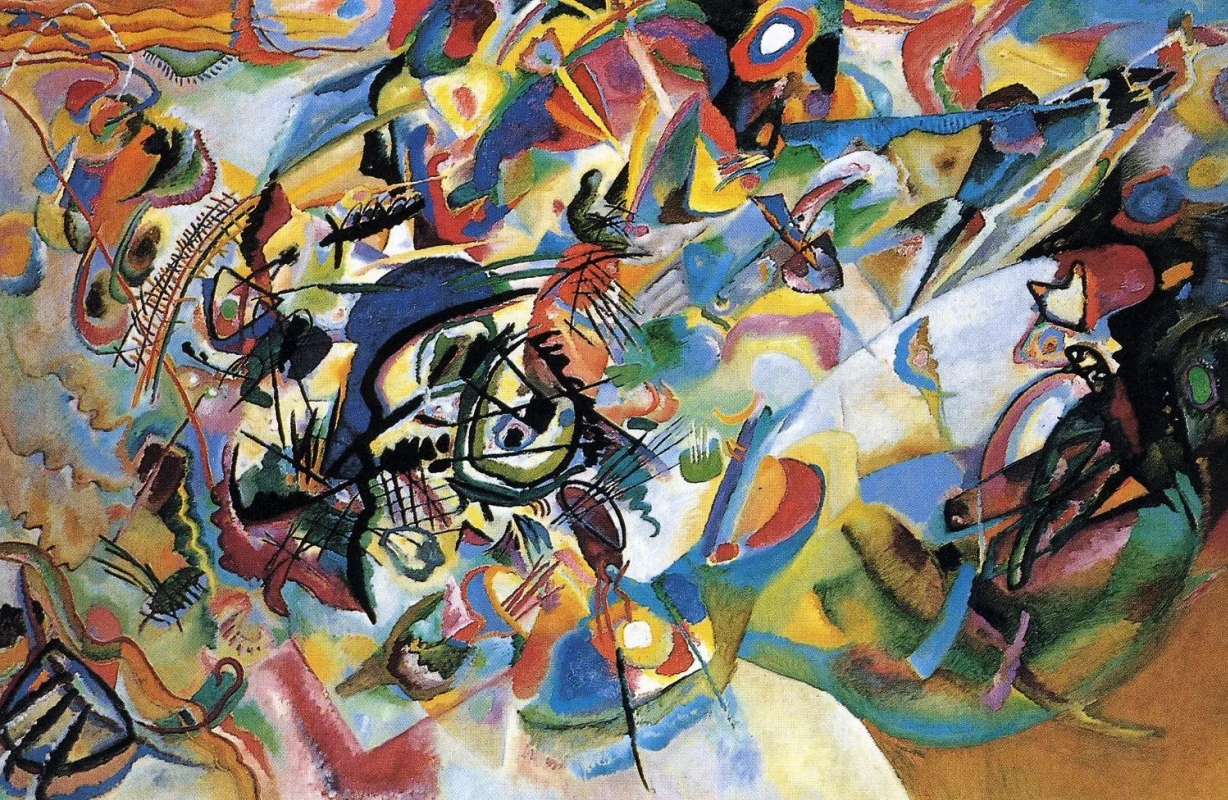log in
Enter site
Login to use Arthive functionality to the maximum
Composizione VII
Wassily Kandinsky • Pittura, 1913, 200×300 cm


















Descrizione del quadro «Composizione VII»
Creata nel 1913, la Composizione VII di Kandinsky è considerata uno dei più grandi capolavori dell'arte astratta. Questo lavoro è una logica continuazione delle Composizioni Ve VI. Tutti e tre i dipinti sono uniti dal tema dell'Apocalisse. Tali elementi della VI Composizione come il Diluvio e la Resurrezione possono essere rintracciati in quest'opera. Il suo tema principale è il giudizio finale, ma non è visto come un disastro ma piuttosto come una liberazione, la transizione del mondo dal materiale allo spirituale. Pertanto, la Composizione VII si differenzia dalle altre opere della serie per i suoi colori chiari e le linee di contrasto lampeggianti.
Kandinsky ha costruito ciascuna delle sue composizioni in modo che lo spettatore potesse entrare nell'immagine come se ruotasse al suo interno. Ha reso il bordo inferiore della composizione più pesante, spingendolo così in avanti, mentre la parte superiore rimane più leggera e più distante per lo spettatore. Uno dei principali contrasti dell'artista, il blu e il giallo costituiscono la zona centrale del movimento attivo verso l'interno e verso l'esterno.
Kandinsky trascorse molti mesi a preparare la sua Composizione VII, ma gli ci vollero solo quattro giorni per dipingerla. L'artista ha realizzato circa 30 studi di questo dipinto (1, 2). Alcuni ricordano Caravaggio o Leonardo Da VinciSono studi dettagliati delle pieghe del tessuto, delle foglie sugli alberi o degli arti umani. Alcuni di essi presentano ripetutamente la stessa linea curva, altri mostrano schematicamente gli elementi strutturali di base della composizione, e alcuni di essi contengono una pianta dettagliata della composizione. Inoltre ci sono circa 15 diversi quadri legati alla Composizione VII: si tratta di schizzi ad olio oa matita, acquarelli, dipinti su vetro e incisioni.
Gabrielle Munter, che ha assistito alla creazione di questo dipinto, ha scritto nel suo diario il 25 novembre 1913 che la tela per la Composizione VII è stata consegnata a casa loro a Murnau, e Kandinsky si è messo al lavoro la sera stessa. La mattina seguente ha scattato la prima fotografia del dipinto e dopo pranzo ha scattato la seconda. La voce del 28 novembre nel diario di Munter diceva che il quadro era completo. Il 29 novembre ha scattato una foto del lavoro finito. Fu così che fu registrata la nascita di un grande capolavoro.
Scritto da Evgheniya Sidelnikova
Kandinsky ha costruito ciascuna delle sue composizioni in modo che lo spettatore potesse entrare nell'immagine come se ruotasse al suo interno. Ha reso il bordo inferiore della composizione più pesante, spingendolo così in avanti, mentre la parte superiore rimane più leggera e più distante per lo spettatore. Uno dei principali contrasti dell'artista, il blu e il giallo costituiscono la zona centrale del movimento attivo verso l'interno e verso l'esterno.
Kandinsky trascorse molti mesi a preparare la sua Composizione VII, ma gli ci vollero solo quattro giorni per dipingerla. L'artista ha realizzato circa 30 studi di questo dipinto (1, 2). Alcuni ricordano Caravaggio o Leonardo Da VinciSono studi dettagliati delle pieghe del tessuto, delle foglie sugli alberi o degli arti umani. Alcuni di essi presentano ripetutamente la stessa linea curva, altri mostrano schematicamente gli elementi strutturali di base della composizione, e alcuni di essi contengono una pianta dettagliata della composizione. Inoltre ci sono circa 15 diversi quadri legati alla Composizione VII: si tratta di schizzi ad olio oa matita, acquarelli, dipinti su vetro e incisioni.
Gabrielle Munter, che ha assistito alla creazione di questo dipinto, ha scritto nel suo diario il 25 novembre 1913 che la tela per la Composizione VII è stata consegnata a casa loro a Murnau, e Kandinsky si è messo al lavoro la sera stessa. La mattina seguente ha scattato la prima fotografia del dipinto e dopo pranzo ha scattato la seconda. La voce del 28 novembre nel diario di Munter diceva che il quadro era completo. Il 29 novembre ha scattato una foto del lavoro finito. Fu così che fu registrata la nascita di un grande capolavoro.
Scritto da Evgheniya Sidelnikova
Articoli sull'opera



